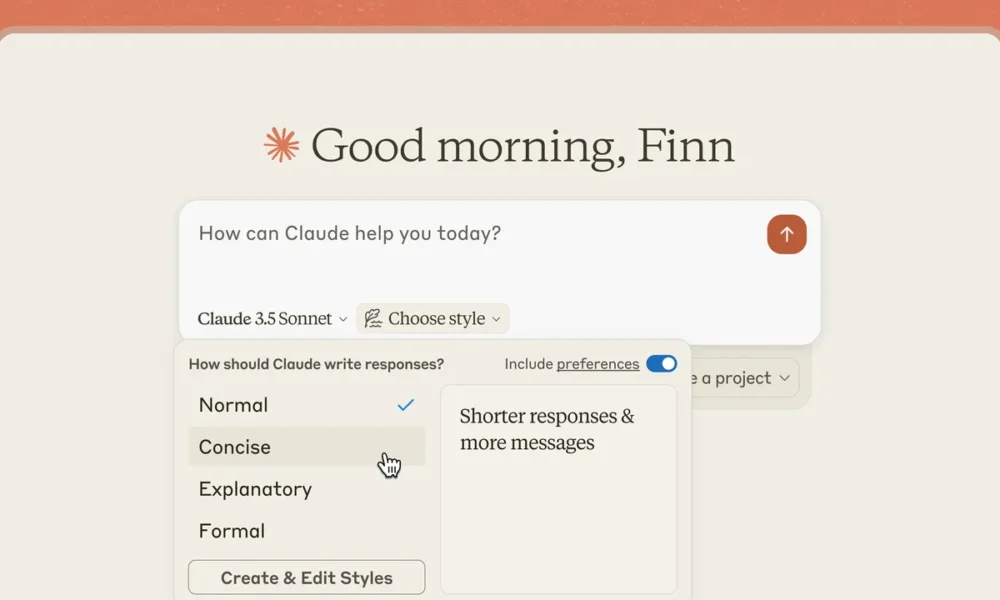Let us start with something we all know – AI responses often sound like they came from AI. Everything might feel a bit too polished, structured, or cliche. That has been one of the biggest hurdles in making AI truly useful for everyday communication.
Picture every AI interaction you have had – they likely often follow the same pattern: precise, technically correct, but missing that human touch. It is like talking to someone who learned communication from a textbook rather than through real conversations.
To finally fix this, Anthropic just rolled out a game-changing feature for Claude that tackles it head-on. Instead of forcing users to adapt to the AI’s way of communicating, they have flipped the script – now Claude adapts to your style.
Why is this such a big deal? Think about how we communicate in real life. You probably do not use the same tone in a team meeting that you use when catching up with friends. You naturally adjust your style based on context. That is exactly what this new feature brings to AI interaction – the ability to match your natural communication patterns.
The Technical Framework
So how does this actually work under the hood? The technology behind Claude’s style adaptation is pretty interesting. Unlike simple text matching or template-based approaches, it is built on advanced pattern recognition that analyzes multiple layers of writing characteristics.
When you interact with Claude, it’s not just processing individual words – it is understanding the entire structure of how you communicate. This includes:
- Sentence patterns and length variation
- Transition style between ideas
- Word choice patterns
- Structural organization preferences
The system comes with three core preset styles that serve as foundational frameworks:
- Formal: For when you need that polished, professional touch
- Concise: When you want straight-to-the-point communication
- Explanatory: Perfect for detailed breakdowns and teaching moments
This flexibility marks a significant shift from the one-size-fits-all approach we’ve seen in previous AI systems.
The training methodology is where things get really interesting. Rather than just mimicking surface-level patterns, Claude analyzes writing samples to understand the deeper structure of communication – the subtle patterns that make your writing uniquely yours. It is like teaching an AI to recognize your communication fingerprint.
Credit: Anthropic
Mastering the Art of Style Training
Let us dive into what makes this system special – the ability to create custom styles that match your way of communicating. It goes beyond simple mimicry.
When you feed Claude writing samples, it is analyzing multiple layers of your communication style:
- How you structure your arguments
- Your unique ways of transitioning between ideas
- Those writing quirks that make your voice distinctly yours
- The way you balance technical depth with accessibility
Here is where the real technical innovation shines. Unlike previous AI systems that relied on basic tone adjustments (think of those old “formal vs. casual” toggles), Claude’s pattern recognition goes much deeper. The system processes your writing samples through multiple analysis layers:
- Surface Layer: Basic elements like word choice and sentence length
- Structural Layer: How you organize and present information
- Contextual Layer: Understanding when and how you shift between different tones
- Pattern Recognition: Identifying your unique writing “fingerprint”
Setting New Standards in AI Communication
What we are seeing here is not just another incremental update but rather a shift in how AI systems understand and replicate human communication patterns.
Here is why this matters:
- Moves beyond template-based responses
- Advanced pattern recognition capabilities
- Dynamic style adaptation in real-time
- Integration with existing language model strengths
Remember when chatbots first appeared? They were basically glorified decision trees. Then came the era of large language models that could generate human-like text, but still in that unmistakably “AI” voice. This new development represents the next evolutionary step – AI that can truly adapt its communication style to match yours.
The competitive landscape is worth noting here. While other AI assistants have basic tone adjustments, they are more like Instagram filters – preset options that feel artificial. Claude’s approach is different because it learns from your actual writing patterns, creating a more authentic replication of your communication style.
Pro Tip: Think of this like teaching AI your personal “communication API” – once it understands your style, every interaction becomes more natural and efficient.
Think about the underlying implications:
- Neural networks that can identify and replicate complex communication patterns
- Advanced context awareness in language processing
- New approaches to training language models
- Potential breakthroughs in cross-cultural communication understanding
Today we are teaching AI to match writing styles. Tomorrow? We might be teaching it to understand and adapt to cultural communication norms across different societies.
The pattern recognition technology powering these style adaptations could revolutionize other areas of AI development:
- Medical diagnostics that adapt to different patient communication needs
- Financial systems that match reporting styles across different regulatory frameworks
- Legal AI that can switch between different jurisdictional writing requirements
- Educational systems that automatically adjust to individual learning patterns
The technical implications extend far beyond just making AI sound more natural. We’re looking at fundamental improvements in how machines process and adapt to human behavioral patterns.
What is really exciting is how this might influence the development of future AI architectures. Could we see neural networks specifically designed for dynamic adaptation? Will this lead to new approaches in machine learning that we have not even considered yet?
The new customized writing styles and tones from Claude could potentially lay the foundation for an entirely new approach to human-AI interaction. And that is what makes this development truly groundbreaking.




